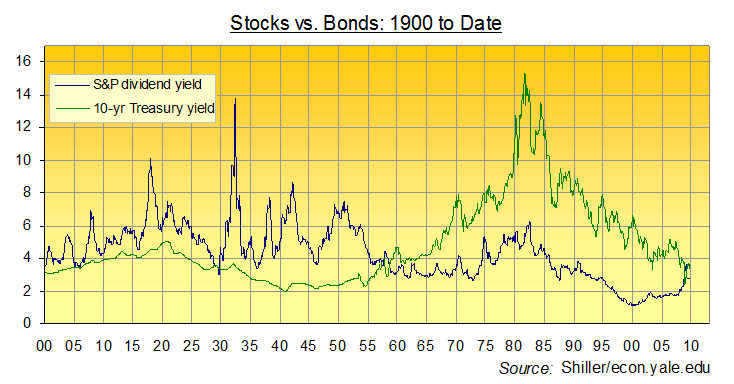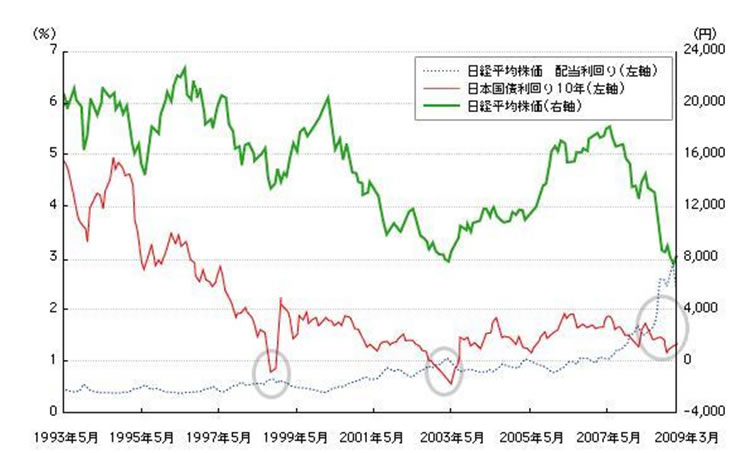Stocks vs. Bonds, 5-Decade Anomaly of Returns
Stock-Markets / Financial Markets 2009 Oct 21, 2009 - 02:50 PM GMTBy: Adrian_Ash
 Stocks now pay way less than bonds once again, but neither pay much...
Stocks now pay way less than bonds once again, but neither pay much...
BLINK and you missed it. US equities offered a greater yield on investment than did US Treasury bonds for less than five months...
And from the day this oddity struck, 18 Nov. 2008, the S&P still had another one-fifth to fall.

"When this inversion occurred, my two older partners assured me it was an anomaly," wrote the late Peter Bernstein in Nov. 2008.
The inversion Bernstein referred to had occurred five decades earlier...back when the dividend yield offered by US equities slipped below the yield offered by Treasury bonds for only the second time in history.
Wake up there at the back! This might be important. Because in 1958, savings were offered a lower return as risk capital in US business than as a loan to Uncle Sam. Which was absurd. The only other time this had happened – and only then for six months – was right at the top of the 1929 stock bubble.
And you can see how the Great Crash fixed that anomaly on our chart above.
"The markets would soon be set to rights," Bernstein's senior partners agreed just as Elvis was getting his Fort Chaffee crew-cut, "with dividends once again yielding more than bonds. That was the relationship ordained by Heaven, after all, because stocks were riskier than bonds and should have the higher yield."
High risk equals higher return, right? Risk-free bonds should pay less per year...just as they had done for as long as anyone dared to remember. US equities, on Robert Shiller's data at least, offered an average yield 1.8% above Treasuries between 1871 and 1958.
How's that for a law of the universe?
But what Nature ordains and how investors behave are two different things, as early bears too often find to their cost. London's Tony Dye moved $10 billion of his clients' money out of stocks into bonds in 1995. Come March 2000, he was forced to step down as chief investment officer at PDFM, just as his call came good. (Dye then called the top of the real-estate bubble...in 2004.) And what seemed aberrant to old hands in the mid-20th century has since become hard financial fact. Stocks offered to yield 3.7% less than bonds in the fifty years to last November, even though Uncle Sam was obliged to repay you in full at redemption, while no one was (or is) obliged to buy your stock at the price you (or anyone before you) paid.
Forget risk, just get used to it. This iron law even got a name – the Fed Funds Model, based on the idea that Fed officials in the mid-90s were actively targeting stock prices by working long bond yields – and became so entrenched during the five decades to last Christmas, you could hang your jacket on the bullishness sparked by any hint of reversion.
"A record percentage of companies [now have] dividend yields that are greater than the yield on the 10-year US Treasury note," said a report from $10bn Concord Asset Management in Chicago in March 2009. "At 45%, that is over 4 times higher than in 2002...and for one of the few times in modern history, stocks now yield comfortably more than Treasury bonds and money market funds."
Buy, Buy, Buy! in short. And to date (meaning the last 8 months) it's proved a smart call. Because the first 50 years of contemporary finance won't be beat. Not on Wall Street at least. Not yet.
But in Japan...?
"This may sound boringly technical but it really is worth noting," noted the London Evening Standard in November 2007. "The dividend on Japanese stocks has moved higher than the yield on Japanese government bonds (JGBs). [And] in the past, every time this has happened (1998, 2003 and 2005 in recent memory) the Japanese market has soon found itself in the grip of a massive rally.
"All the signs are that the same thing might happen this time."

Sadly, however, no dice. The magic of stocks yielding more than "risk-free" bonds (we'll come back to the scare quotes in a second) worked right up until it didn't – Nov. 2007 – when the fast-falling Nikkei just kept falling, pushing the dividend yield up to multi-decade highs...even as JGB yields continued to drop. (Hat tip to Matsunosuke blogging at Ameblo.jp for the chart...)
Beyond a globally synchronized slump, what gives?
"As investors pondered this upside-down yield spread after 1958," Bernstein wrote a little less than 12 months ago, "two explanations (rationalizations?) began to circulate." First, by the late 1950s, the Great Depression was finally becoming a distant memory, together with its record of destroying equity while gifting deflationary gains to sovereign-bond rentiers. Second, the idea of growth-stock investing – propounded by young guns such as Bernstein himself – was starting to take hold.
Capital growth in the value of stocks would be paid in lieu of strong dividend income. Who needed yield when you got gains? Put another way, as did Robert Arnott, now head of institutional advisory Research Affiliates, when speaking to Barrons last November, "Growth was in the air [after World War II]...so yield plus growth (stocks) could trump yield alone (bonds.) For the next 50 years, that was the norm."
But Bernstein ventured a third explanation for the switch from risk-free bonds to high-growth stocks: "Inflation." His technical study, built on the correlations between equity dividends and T-bond yields, was typically detailed, thorough and possibly obtruse. Since there's no time to recount it here, and at the risk of bowdlerizing Bernstein's analysis (and upsetting his shade any further), let's cut to the chase:
Inflation makes bonds a worse risk than stocks. Hence the fillip from yields.
Given that last year's reversion, and this year's switch back, happened at a level of dividend yields "about the same as in September 1929 and lower than at all other stock-market peaks of the 20th century" according to Bob Prechter, we'll leave second-guessing where the anomaly now lies to you.
The cross-over also came with Treasury yields down at unheard of lows. "People are too optimistic [in stocks] about making capital gains," reckons Prechter. They might be too optimistic about getting their T-bonds redeemed at fair value as well.
By Adrian Ash
BullionVault.com
Gold price chart, no delay | Free Report: 5 Myths of the Gold Market
City correspondent for The Daily Reckoning in London and a regular contributor to MoneyWeek magazine, Adrian Ash is the editor of Gold News and head of research at www.BullionVault.com , giving you direct access to investment gold, vaulted in Zurich , on $3 spreads and 0.8% dealing fees.
(c) BullionVault 2009
Please Note: This article is to inform your thinking, not lead it. Only you can decide the best place for your money, and any decision you make will put your money at risk. Information or data included here may have already been overtaken by events – and must be verified elsewhere – should you choose to act on it.
Adrian Ash Archive |
© 2005-2022 http://www.MarketOracle.co.uk - The Market Oracle is a FREE Daily Financial Markets Analysis & Forecasting online publication.



